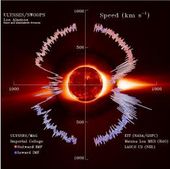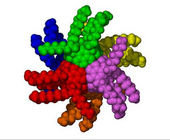
© NASAThe solar wind, shown here in a plot of data from the Ulysses spacecraft, flows away from the sun at a million miles per hour and is heated by a "turbulent cascade."
The solar wind is hotter than it should be, and for decades researchers have puzzled over the unknown source of energy that heats it. In a paper published in the June 12 issue of
Physical Review Letters, NASA scientists say they may have found the answer.
"The energy source is turbulence," says co-author Melvyn Goldstein, chief of the Geospace Physics Laboratory at NASA's Goddard Space Flight Center, Greenbelt, Md. "The sun heats the solar wind by stirring it up."
It's a bit like stirring your coffee--in reverse. When you stir your morning cup of Joe, the coffee cools off. But when the sun stirs the solar wind, the solar wind heats up.
Consider the coffee. When you stir it with a spoon, the stirring produces swirls and vortices in the liquid. The vortices fragment into smaller and smaller eddies until, at the smallest scales, the motions dissipate and the energy turns into heat. Because energy cascades down from the large swirls to the smaller ones, the process is called a turbulent cascade.
Theoretically, the turbulent cascade should heat the coffee. Real coffee cools off, however, because the act of stirring brings warm coffee from the depths of the cup into contact with cooler air above. Cool air absorbs the heat - the heat the coffee had to begin with plus the heat you added by stirring - and you can take a sip without scalding yourself.

